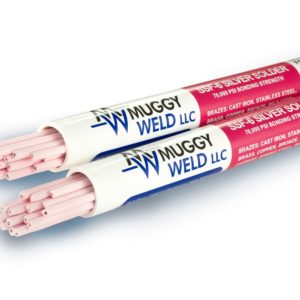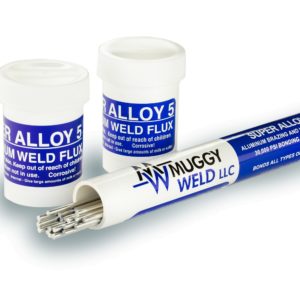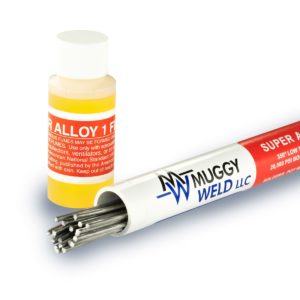Thick to thin aluminum welding tips with Super Alloy 5 aluminum welding rods
Often we are asked whether or not Super Alloy 5 can join thick pieces of aluminum to thin pieces. Of course!!
In this clip we join a thick, heavy section of aluminum to a thin piece of aluminum tubing using an oxyacetylene torch.
Unlike other aluminum brazing rods, you will notice the Super Alloy 5 flux not only acts as a temperature guide–flowing when the base metal reaches 600°F, but the flux also cleans the area of dirt, paint, grease etc. This unique feature eliminates the need to wire brush, sandblast, or use acids to pre-clean your aluminum.
Technique is important. Aluminum melts at 1220°F and does not change color before it liquefies, so it’s important to focus the torch heat on the thick aluminum piece to avoid overheating the aluminum (and melting it onto the floor.) If you concentrate the heat on the thick aluminum, the thin aluminum will gradually reach working temperature without applying any heat directly to it.
If the aluminum is located near a heat sensitive surface, we recommend pairing Super Alloy 5 with Heat Freeze Heat Paste.
Apply the flux to the joint using the aluminum welding rod, and continue to apply heat to the thick piece of aluminum. It will transform into a liquid when the thick piece has been heated to working temperature. Once the flux has liquefied, apply the rod. If the flux turns black instead of liquefying, simply wash it off with warm water and a wire brush and begin again.
Because the flux follows the heat and the rod follows the flux, welding even hard to reach areas is an easy process.
Continue to alternate applying rod and flux until the joint has been sealed completely, then allow aluminum to cool naturally.
Remove any residual flux as directed above, and you’re done.
Disclaimers:
Please visit https://www.aws.org/Standards-and-Publications/Free-Resources/#YourResources prior to using Muggy Weld products, and adhere to all AWS welding safety guidelines.
Further product safety information is available at http://muggyweld.com/safety-guidelines
Muggy Weld LLC shall not be liable for any loss, injury, claim, liability, or damage of any kind resulting in any way from (a) your use of this Site, (b) any services or products obtained from this Site, (c) any errors in or omissions from this Site, (d) the unavailability or interruption of this Site or any features thereof, (e) any content contained on this Site.
MSDS sheets available with purchase from MuggyWeld.com, upon request.
Check Out These Products
-

SSF-6 Silver Solder Rod: Flux-Coated SSF-6 56% Brazing Rod
$69.00 – $260.00High-Strength, 56% Silver Solder Rod🌡 Melting Temperature 1150 / 621 ⇄︎ Bonding Strength 70000 psi, 482.63 MPa 🔧︎ Sizes Available (in) 1/16 🔧︎ Sizes Available (mm) 1.58 -

Super Alloy 5 Aluminum Welding and Brazing Rod
$69.00 – $109.00600°F aluminum welding, brazing, and soldering rod. Ideal for aluminum boat repair and cast aluminum.🌡 Melting Temperature 600 / 317 ⇄︎ Bonding Strength 30000 psi, 206.84 MPa

